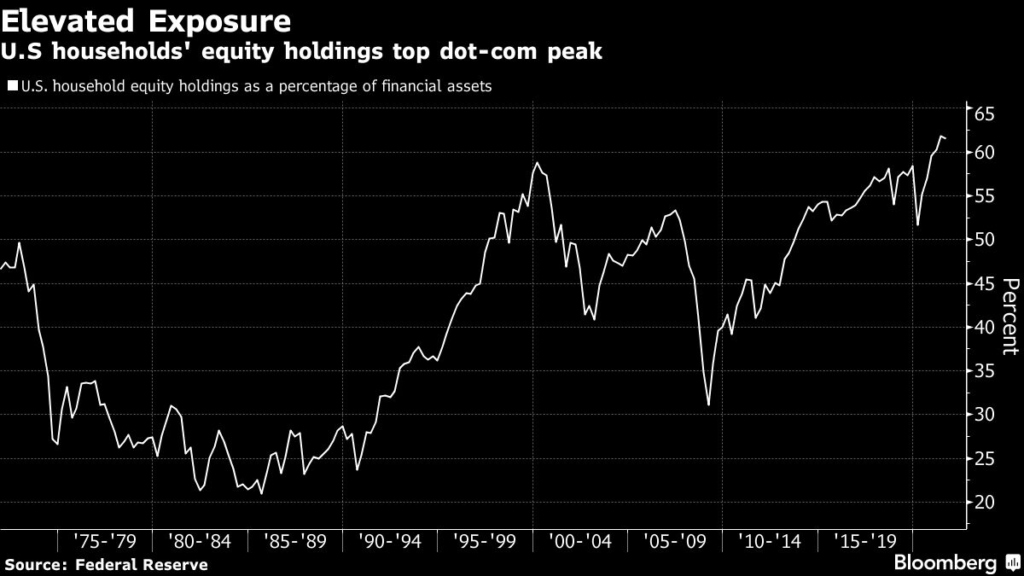(Bloomberg) — Stocks are near records, but people are worried. Not about valuations, or earnings, or even the resurgent virus, going by price action in the last week. What’s bothering people is Federal Reserve policy, which separate surveys named as the market’s biggest bugaboo at the end of the year.
That’s new. Seemingly forever, central banks have stood as one of the staunchest allies of equity bulls. They stepped in in 2020 when markets plunged. They reversed course in 2019 after a brutal quarter. They’ve rushed to the scene of virtually every bout of volatility for more than a decade, underpinning a bull market that has helped the S&P 500 rise ninefold, dividends included.
Has something changed? Yes, say a growing chorus of analysts who see the sands shifting in the direction of a less responsive Fed that’s suddenly laser-focused on combating inflation clocking in north of 8%. Simply put, they say, it’s going to take a lot more than it used to for markets to get Jerome Powell’s attention.
“The economy and the consumer are in OK or solid shape, so I think their tolerance is much higher, and the market’s implied or perceived Fed put is lower,” said Chris Harvey, head of equity strategy at Wells Fargo & Co. “The harder question is how much lower.”
According to Mike Wilson, Morgan Stanley’s chief U.S. equity strategist, the so-called Fed put would only kick in when the S&P 500 suffers a peak-to-trough decline of at least 20%, unless credit markets or economic data start to wobble. In September 2020, the S&P 500 fell to the brink of a 10% correction and the Fed rushed to assure investors that interest rates would stay near zero for at least three years.
Read More: New Era of Bond-Market Volatility Begins as Fed Fights Inflation
A higher bar reflects the economic and political reality. With inflation running near a 40-year high, Fed Chair Powell would have a hard time justifying any dovish move. Moreover, President Joe Biden is far less fixated with the stock market than his predecessor, Donald Trump, who viewed equity performance as one yardstick for his own success.
“We think Jay Powell and the Fed will be under much less pressure from the White House versus the last time they tried to take the punch bowl away in late 2018,” Wilson wrote in a note this week. “The Fed put still exists but the strike price is much lower now.”
That’s not good news for investors fretting the stock market is heading for trouble. Underneath the surface of what looked like a resilient market, cracks are opening, with more stocks falling to new lows. While the S&P 500 is within 2% of its all-time high, half of the Russell 3000 members are mired in their individual bear markets, with its average stock down 27% from the recent peak.
The drumbeat of warnings is getting louder. Ed Clissold, chief strategist at Ned Davis Research, sees the potential for an earnings slowdown and tighter Fed policy to push U.S. equities into “a shallow bear market” next year before the S&P 500 bounces back to end modestly higher.
The proportion of newsletter writers classified in Investors Intelligence’s survey as being in the bear camp increased to to 25.3% last week, the highest since early 2020, data compiled by Yardeni Research show.
In some speculative corners of the market, pains are already building for individual investors as their beloved investments went awry. From meme stocks to hyper-growth shares and cryptocurrencies, losses have piled up in recent weeks as the prospects of higher interest rates prompted traders to reassess risk.
A basket of meme stocks like GameStop Corp. has lost 40% of value from its January peak, while Cathie Wood’s ARK Innovation ETF (ticker ARKK) is down 26% this year.
“What the Fed giveth, they are now gearing to take away,” said Chris Weston, head of research at Pepperstone Financial Pty. “The former liquidity beneficiaries have been smashed and look incredibly vulnerable.”
Yet with so much of American’s wealth tied to equities, many argue the Fed can’t afford to let the market crash, either. As of the end of the third quarter, stocks accounted for 62% of total financial assets held by households, well above the last major peak in 2000, Fed data show.
Still, anyone downplaying a less supportive Fed will face a rude awakening, according to Bank of America Corp. strategists led by Benjamin Bowler. While the strategy of buying the dip is poised for one of its most profitable years in history, the Fed’s hawkish shift leaves the trade on borrowed time, they warned, drawing a parallel to what happened in 2018.
In October of that year, Powell famously said that despite several increases, policy rates remained “a long way” from neutral and that financial conditions were “accommodative.” Almost three months later, the S&P 500 was points away from a bear market. Powell then took a U-turn, starting to cut rates in 2019, after Trump blamed the Fed for the equity carnage.
“Even in 2018, when Powell showed less concern for risk assets than his predecessor, it took time for the market to look down and realize its safety net was much lower than it used to be,” Bowler wrote in a note. “The risk to this policy-fueled, riskless rally is even larger today as inflation constrains the Fed.”
More stories like this are available on bloomberg.com
©2021 Bloomberg L.P.











